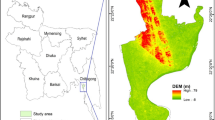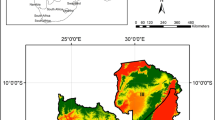Abstract
Dynamic processes such as environmental, economic, and social factors influence land use and land cover (LULC) changes, with temporal and spatial variations. This study aims to identify changes in LULC and predict future trends in the Pakhal Lake area in Peninsular India. Satellite images for the years from 2016 to 2022 were used for LULC classification using deep learning with Sentinel − 2 imagery in Google Earth Engine (GEE). Dynamic World dataset is used to classify the LULC changes of the study area with a 10 m near-real-time dataset. Images were classified based on six different LULC classes, namely water, vegetation, flooded vegetation, agriculture, built-up area, and bare land. The Cellular Automata–Artificial Neural Network (CA − ANN) technique was used to predict LULC changes. QGIS plugin MOLUSCE with Multi-Layer Perception (MLP), was used to predict and determine potential LULC changes for 2025 and 2028. The overall Kappa coefficient value of 0.78, and an accuracy of 82% indicated good results for LULC changes and projected maps for 2025. Prediction of LULC changes using MLP − ANN for the years 2025 and 2028 showed increase in agriculture, built-up areas, and barren land. The results of the study will be useful to develop better management techniques of natural resources.






Similar content being viewed by others
References
Nurwanda, A., & Honjo, T. (2020). The prediction of city expansion and land surface temperature in Bogor City, Indonesia. Sustainable Cities and Society, 52, 101772.
Turner, B. L. I. I., Meyer, W. B., & Skole, D. L. (1994). Global Land-Use/Land-Cover change. Towards an Integrated Study Ambio, 23(1), 91–95.
Turner, M. G., & Ruscher, C. L. (1988). Changes in landscape patterns in Georgia, USA. Landscape Ecology, 1(4), 241–251.
Ruiz-Luna, A., & Berlanga-Robles, C. A. (2003). Land use, land cover changes and coastal lagoon surface reduction associated with urban growth in northwest Mexico. Landscape Ecology, 18(2), 159–171.
Rawat, J. S., & Kumar, M. (2015). Monitoring land use/cover change using remote sensing and GIS techniques: a case study of Hawalbagh block, district Almora, Uttarakhand, India. The Egyptian Journal of Remote Sensing and Space Science, 18(1), 77–84.
Lu, D., Mausel, P., Brondizio, E., & Moran, E. (2004). Change detection techniques. International Journal of Remote Sensing, 25(12), 2365–2401.
Reis, S. (2008). Analyzing land use/land cover changes using remote sensing and GIS in Rize, North-East Turkey. Sensors (Basel, Switzerland), 8(10), 6188–6202.
Pervaiz, W., Uddin, V., Khan, S. A., & Khan, J. A. (2016). Satellite-based land use mapping: comparative analysis of Landsat-8, Advanced Land Imager, and big data Hyperion imagery. Journal of Applied Remote Sensing, 10(2), 026004.
Srivastava, P. K., Singh, S. K., Gupta, M., Thakur, J. K., & Mukherjee, S. (2013). Modeling impact of land use change trajectories on groundwater quality using remote sensing and GIS.Environmental Engineering & Management Journal (EEMJ), 12(12).
Dayamba, S. D., Djoudi, H., Zida, M., Sawadogo, L., & Verchot, L. (2016). Biodiversity and carbon stocks in different land use types in the Sudanian Zone of Burkina Faso, West Africa. Agriculture Ecosystems & Environment, 216, 61–72.
Gashaw, T., Tulu, T., Argaw, M., & Worqlul, A. W. (2017). Evaluation and prediction of land use/land cover changes in the Andassa watershed, Blue Nile Basin, Ethiopia. Environmental Systems Research, 6(1), 1–15.
Hyandye, C., & Martz, L. W. (2017). A Markovian and cellular automata land-use change predictive model of the Usangu Catchment. International Journal of Remote Sensing, 38(1), 64–81.
Alam, N., Saha, S., Gupta, S., & Chakraborty, S. (2021). Prediction modelling of riverine landscape dynamics in the context of sustainable management of floodplain: a geospatial approach. Annals of GIS, 27(3), 299–314.
NextGIS (2017). MOLUSCE-Quick and Convenient Analysis of Land Cover Changes.
Aneesha Satya, B., Shashi, M., & Deva, P. (2020). Future land use land cover scenario simulation using open source GIS for the city of Warangal, Telangana, India. Applied Geomatics, 12(3), 281–290.
Rahman, M., Tabassum, F., Rasheduzzaman, M., Saba, H., Sarkar, L., Ferdous, J., & Zahedul Islam, A. Z. M. (2017). Temporal dynamics of land use/land cover change and its prediction using CA-ANN model for southwestern coastal Bangladesh. Environmental Monitoring and Assessment, 189(11), 1–18.
Saputra, M. H., & Lee, H. S. (2019). Prediction of land use and land cover changes for north sumatra, indonesia, using an artificial-neural-network-based cellular automaton. Sustainability, 11(11), 3024.
Achu, A. L., Thomas, J., Aju, C. D., Gopinath, G., Kumar, S., & Reghunath, R. (2021). Machine-learning modelling of fire susceptibility in a forest-agriculture mosaic landscape of southern India. Ecological Informatics, 64, 101348.
Biswas, H., Raizada, A., Mandal, D., Kumar, S., Srinivas, S., & Mishra, P. K. (2015). Identification of areas vulnerable to soil erosion risk in India using GIS methods. Solid Earth, 6(4), 1247–1257. https://doi.org/10.5194/se-6-1247-2015.
Ashaolu, E. D., Olorunfemi, J. F., & Ifabiyi, I. P. (2019). Assessing the spatio-temporal pattern of land use and land cover changes in Osun drainage basin, Nigeria. Journal of Environmental Geography, 12(1–2), 41–50.
Hakim, A. M. Y., Baja, S., Rampisela, D. A., & Arif, S. (2019, June). Spatial dynamic prediction of landuse/landcover change (case study: tamalanrea sub-district, makassar city). In IOP Conference Series: Earth and Environmental Science (Vol. 280, No. 1, p. 012023). IOP Publishing.
Guidigan, M. L. G., Sanou, C. L., Ragatoa, D. S., Fafa, C. O., & Mishra, V. N. (2019). Assessing land use/land cover dynamic and its impact in Benin Republic using land change model and CCI-LC products. Earth Systems and Environment, 3(1), 127–137.
El-Tantawi, A. M., Bao, A., Chang, C., & Liu, Y. (2019). Monitoring and predicting land use/cover changes in the Aksu-Tarim River Basin, Xinjiang-China (1990–2030). Environmental Monitoring and Assessment, 191(8), 1–18.
Bhattacharya, R. K., Chatterjee, D., N., & Das, K. (2021). Land use and land cover change and its resultant erosion susceptible level: an appraisal using RUSLE and logistic regression in a tropical plateau basin of West Bengal, India. Environment Development and Sustainability, 23(2), 1411–1446.
Das, S., & Sarkar, R. (2019). Predicting the land use and land cover change using Markov model: a catchment level analysis of the Bhagirathi-Hugli River. Spatial Information Research, 27(4), 439–452.
Perović, V., Jakšić, D., Jaramaz, D., Koković, N., Čakmak, D., Mitrović, M., & Pavlović, P. (2018). Spatio-temporal analysis of land use/land cover change and its effects on soil erosion (case study in the Oplenac wine-producing area, Serbia). Environmental Monitoring and Assessment, 190(11), 1–18.
Kamaraj, M., & Rangarajan, S. (2022). Predicting the future land use and land cover changes for Bhavani basin, Tamil Nadu, India, using QGIS MOLUSCE plugin. Environmental Science and Pollution Research, 1–12.
Funding
No fund was received from any source for this research, which is part of PhD research.
Author information
Authors and Affiliations
Corresponding author
Ethics declarations
Compliance with ethical standards
There is no conflict of interest. On behalf of all the authors, the corresponding author claims that there is no conflict of interest.
Additional information
Publisher’s Note
Springer Nature remains neutral with regard to jurisdictional claims in published maps and institutional affiliations.
Rights and permissions
Springer Nature or its licensor (e.g. a society or other partner) holds exclusive rights to this article under a publishing agreement with the author(s) or other rightsholder(s); author self-archiving of the accepted manuscript version of this article is solely governed by the terms of such publishing agreement and applicable law.
About this article
Cite this article
Amgoth, A., Rani, H.P. & Jayakumar, K.V. Exploring LULC changes in Pakhal Lake area, Telangana, India using QGIS MOLUSCE plugin. Spat. Inf. Res. 31, 429–438 (2023). https://doi.org/10.1007/s41324-023-00509-1
Received:
Revised:
Accepted:
Published:
Issue Date:
DOI: https://doi.org/10.1007/s41324-023-00509-1




